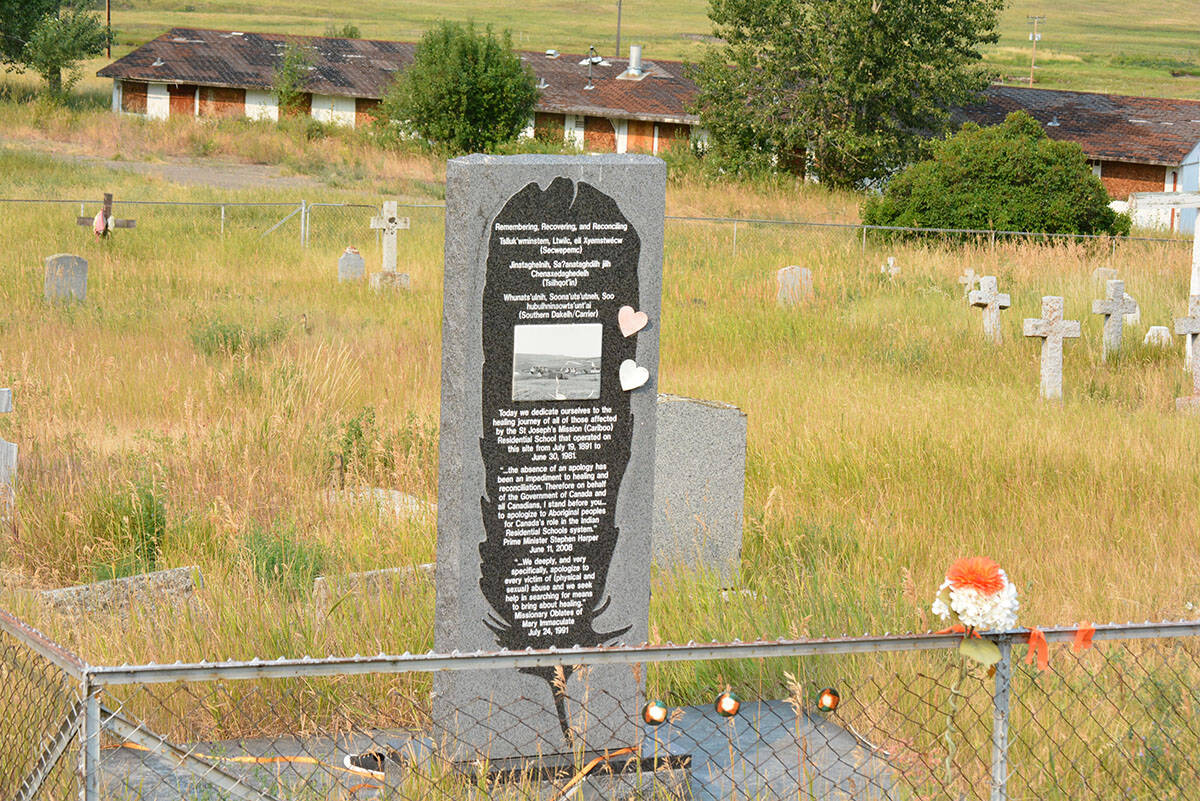As Williams Lake First Nation (WLFN) prepares to share preliminary findings from a geophysical investigation of the former St. Joseph’s Mission Indian Residential School site, Chief Willie Sellars said he is feeling anxious.
The T’ēxelc (WLFN) chief received the final report last week from the ground penetrating radar work and since then has been preparing a speech and presentation to share Tuesday, Jan. 25.
After the revelation on May 31, 2021 of 215 unmarked graves at the former Kamloops Indian Residential School site, WLFN announced in June it planned to investigate the St. Joseph’s Mission site. The ground analysis began on Aug. 31.
“It is really tough not to get emotional,” Sellars told Black Press Media Monday.
“No time is a good time to release the findings from the investigation, but there needs to be truth in order for there to be healing. My biggest worry and concern is making sure everybody is OK and supporting those individuals who are hurting and struggling and are going to be triggered from our announcement tomorrow (Jan. 25).”
On Tuesday morning WLFN will host a closed meeting at its administration building, located just south of Williams Lake, a few kilometres from the St. Joseph Mission site, to share the findings with chiefs and answer their questions.
“We have a strong collection of regional leaders, leaders from around the province, our regional chief and our national chief attending,” Sellars said, noting the federal Minister of Indigenous Services Marc Miller and provincial Minister of Indigenous Relations and Reconciliation Murray Rankin will also attend the media conference by phone.
Tuesday afternoon at 1 p.m. there will be a media conference to share the findings with the public and answer reporters’ questions.
To help survivors, WLFN has a team focused on health and wellness in the community, and resources have beenon the nation’s social media and website.
“We have proactively reached out to every chief in the province, offering our assistance and our help,” Sellars said.
A large number of news agencies from around the world have requested interviews or to be in attendance.
The site of St. Joseph’s Mission is located six kilometres from the WLFN community of Sugar Cane southeast of Williams Lake.
St. Joseph’s first opened in July 5, 1867 and was run by the Oblates of Mary Immaculate, a Roman Catholic order.
A school opened there in 1872 for First Nations and non-First Nations students, and by 1886 it became a residential school for Indigenous children.
Thousands of children from First Nations communities attended the school, including Nuxalk from Bella Coola, Dakelh from Anahim Lake, Tsilhqot’in from Tl’etinqox, ?Esdilagh, Yunesit’in, Xeni Gwet’in and Tl’esqox and Northern Secwépemc from Xatśūll Cmetem, Stswēceḿc Xgāt’tem, Tsq’ēsceń and T’ēxelc.
The school closed permanently in 1981.
Testimonials of physical, emotional and sexual abuse, as well as deaths at the former site have been repeatedly shared over the years, including at the 2013 National Truth and Reconciliation Commission in Williams Lake.
GeoScan, the company hired to do ground penetrating radar, worked in cooperation with Sugar Cane Archaeology at the St. Joseph’s site. Laser scanning, as well as interviews and archival research have also been part of the project.
The preliminary investigation has inspected 150,000 square metres, which include historic buildings such as the gym, a barn and the area where the school was located. A larger area of 450 hectares will be included as part of the continuing overall investigation.
Project co-ordinator Whitney Spearing previously told the Williams Lake Tribune the team worked with the provincial attorney general and public solicitor general regarding access to records that involve persons of interest reports and other compiled documentation gathered during the Truth and Reconciliation Commission hearings held between 2007 and 2015.
“All of the geophysical research eventually has to tie back to people,” she said. “That’s the end goal, not to know how many anomalies there are but to actually to be able to correlate who may potentially be buried out there on the site.”
The research team also reviewed a collection of photographs from St. Joseph’s Mission belonging to the personal archives of Charlene Belleau, a lifelong advocate for Indigenous people.
In July Belleau was appointed by the BC Ministry of Indigenous Relations and Reconciliation to act as a communication link between B.C. First Nations communities and federal and provincial government agencies, and provide advice to the province on matters related to former residential school and hospital sites in B.C. She is working with Spearing’s team.
Tsilhqot’in National Government tribal chair Chief Joe Alphonse, who represents six Tsilhqot’in communities west of Williams Lake, has voiced his concern over the investigation and announcement to come.
He told Black Press Media Friday, Jan. 21, he does not plan to attend the chiefs meeting because he does not support the way the investigation is being carried out with WLFN in charge.
“This is a special case because kids from every nation attended. The process should have all nations work together,” Alphonse said. “At the end of the day, there is a need to keep moving forward with this project, but they aren’t doing it the right way. That’s our biggest concern.”
Alphonse, who was part of a traditional healing ceremony at the grounds of the former St. Joseph’s Mission in June, 2021, said he would have preferred to see a committee formed with every nation whose children attended the school represented during the investigation.
Read More: Our Hometown: Culturally connected – Charlene Belleau
READ MORE: Indigenous communities rocked by Kamloops residential school burial discovery
news@wltribune.com
Like us on Facebook and follow us on Twitter

